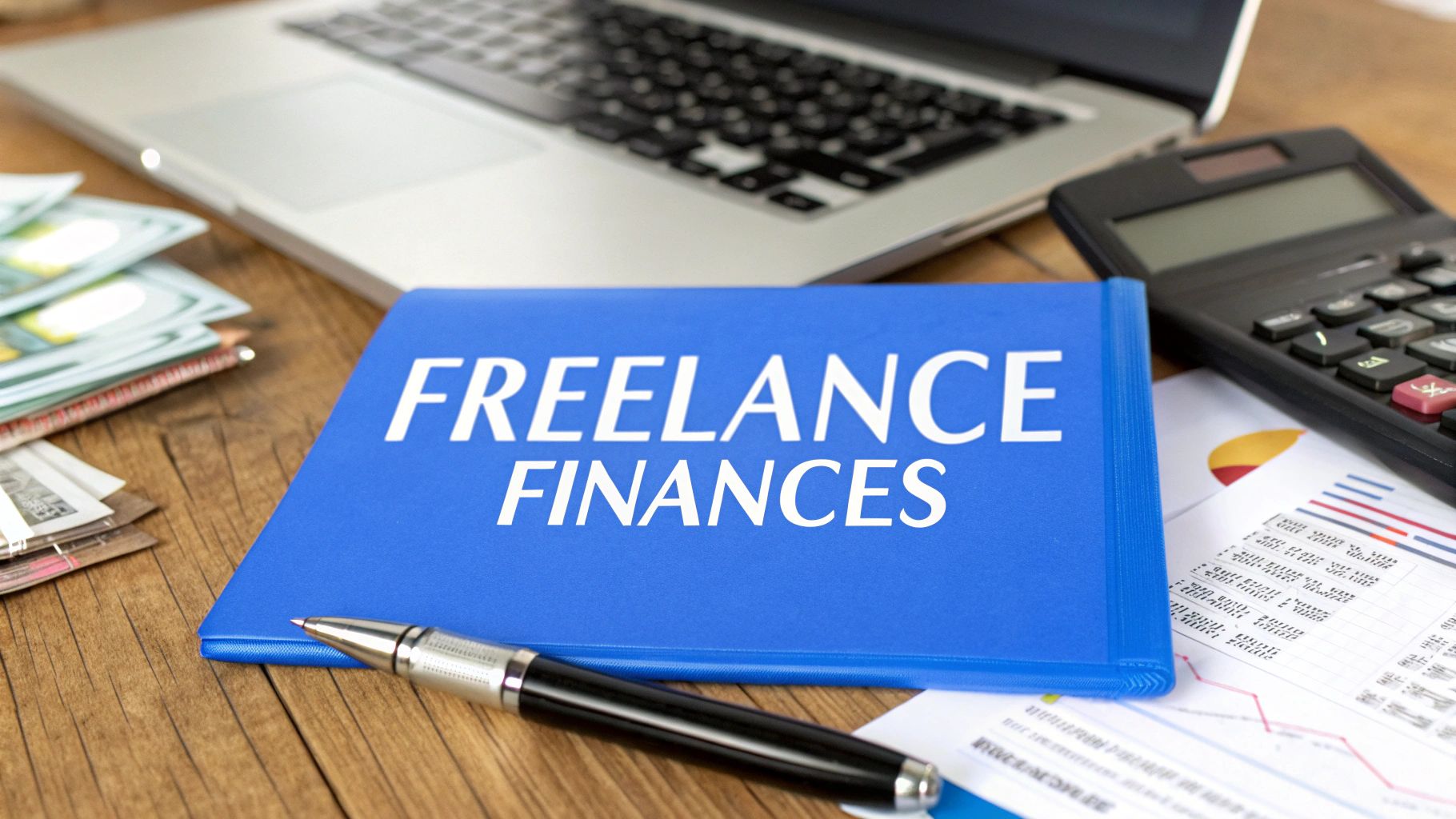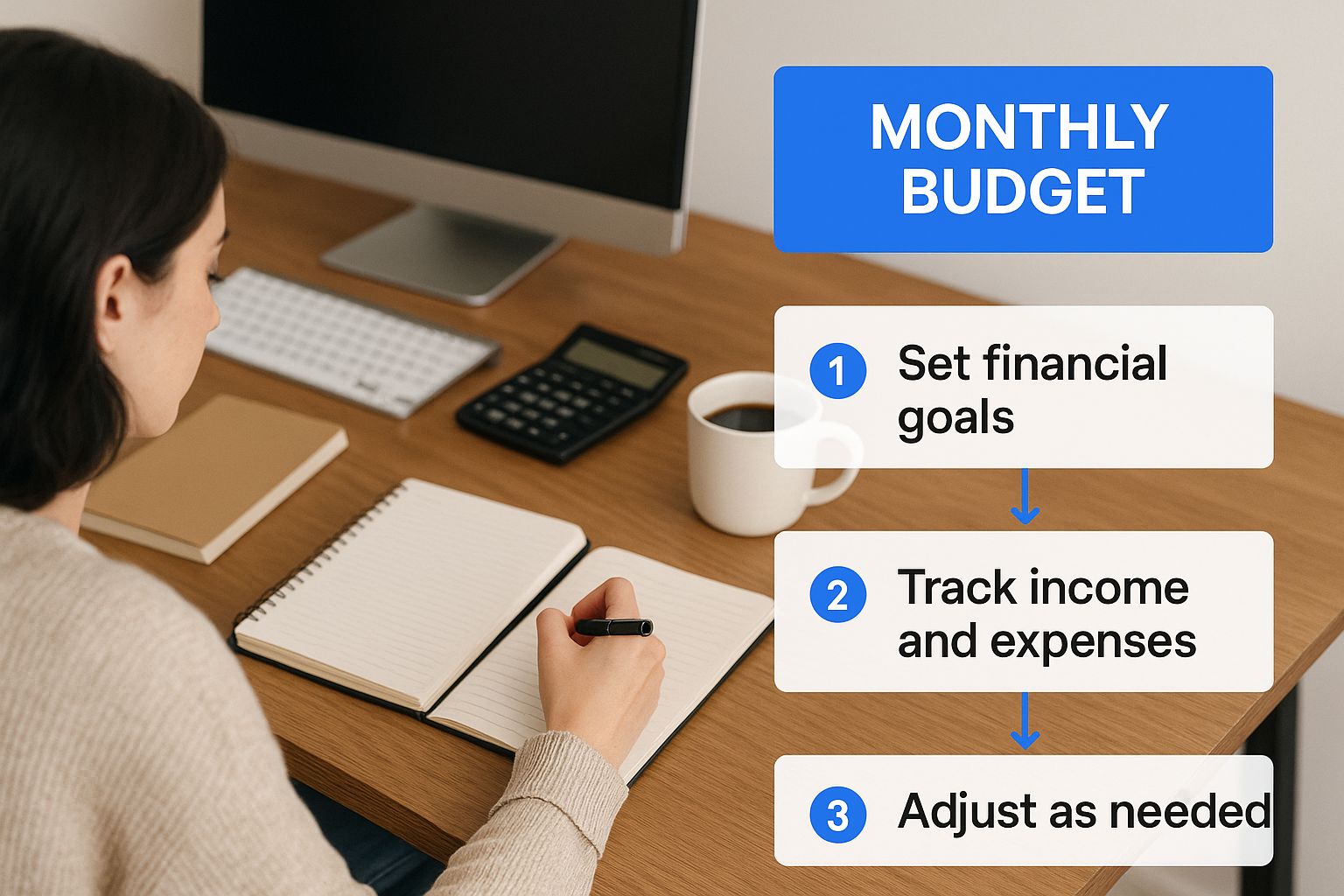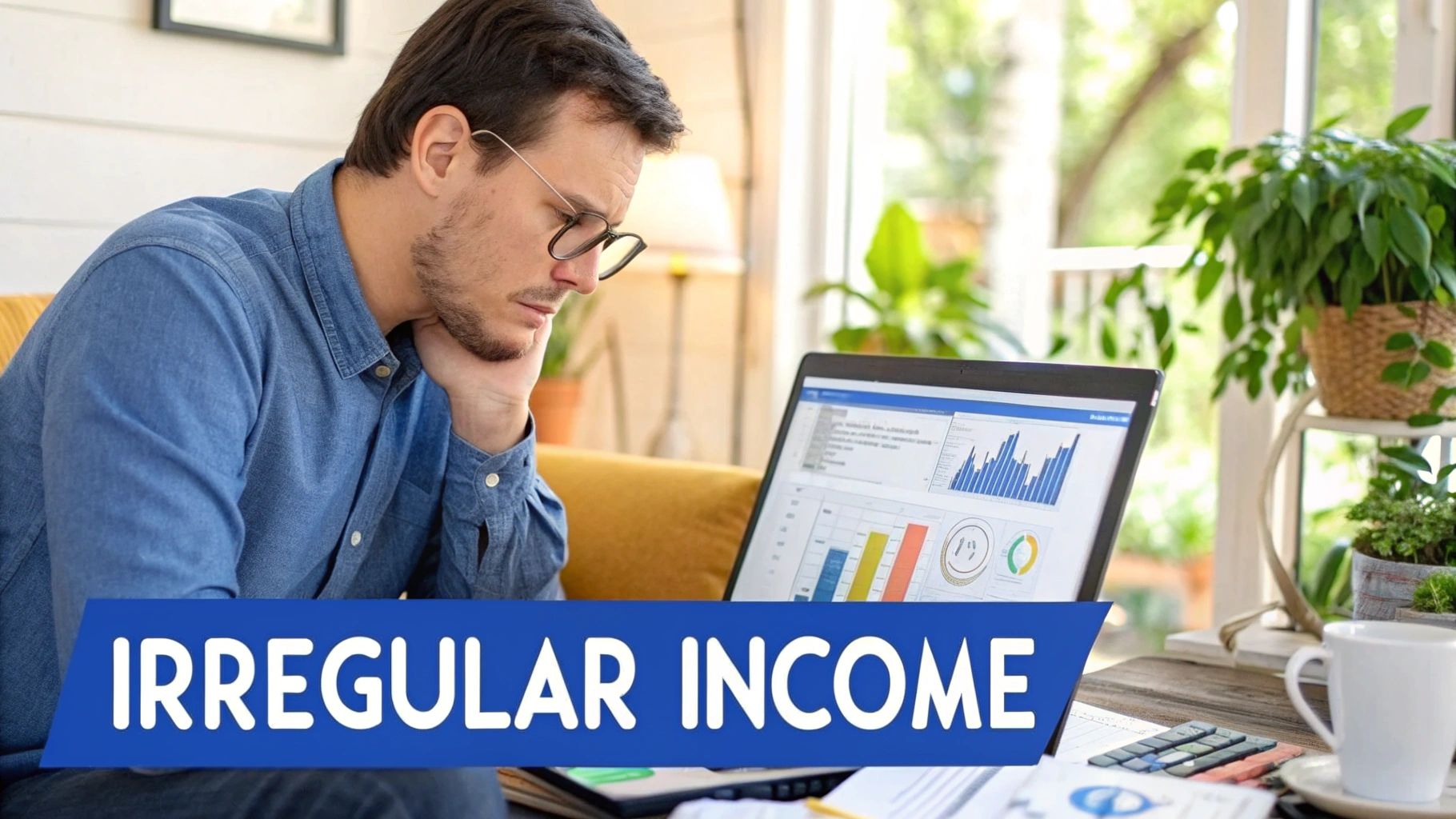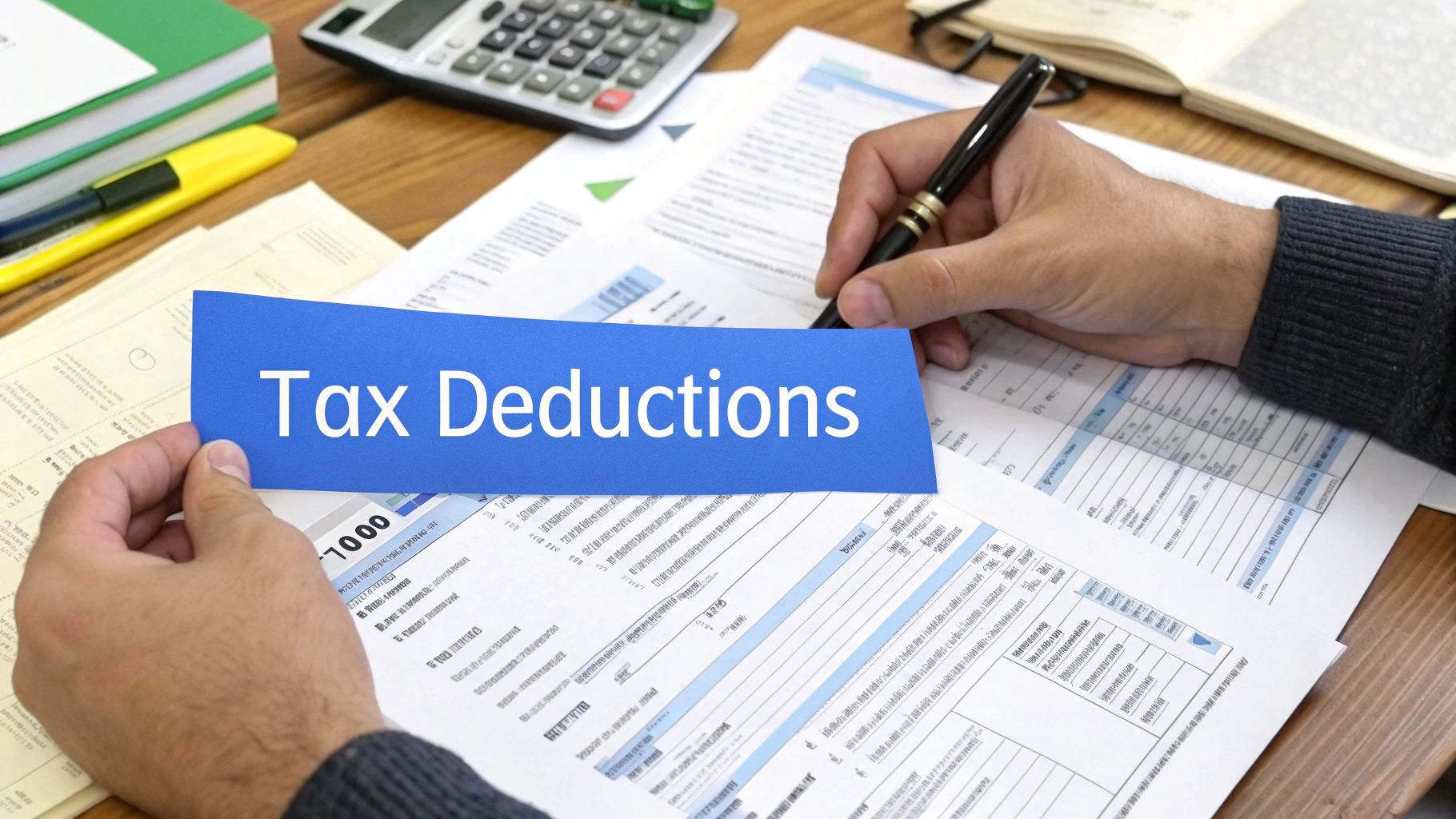Our Marketing Team at PopaDex
Financial Planning for Freelancers: Essential Tips & Strategies

So you’ve taken the leap into freelancing. Congratulations! Beyond the thrill of being your own boss lies a new financial reality. The real challenge—and the biggest opportunity—is managing unpredictable income, staring down self-employment taxes, and planning for your future without a corporate safety net.
Let’s be clear: solid financial planning for freelancers isn’t a chore. It’s the single most powerful tool you have for building a career that’s not just independent, but truly sustainable.
Why Your Financial Plan Matters More Than Ever
Thriving as a freelancer means you have to become your own Chief Financial Officer. There’s no predictable bi-weekly paycheck, no automatic 401(k) contribution, no HR department handling your benefits. Your financial stability rests entirely on the systems you build for yourself. This guide is your framework for taking back control and shifting from a reactive “feast or famine” mindset to proactive, strategic management.
The freelance economy isn’t a niche trend; it’s a massive shift in how we work. It’s projected that by 2025, nearly two out of every five U.S. workers will be freelancing in some capacity. That’s a huge number of people facing the same core challenge: navigating irregular income when clients pay on their own schedules, not yours. You can dig deeper into the numbers and what they mean for your wallet with these freelancer finance statistics from News4Jax.com.
The Pillars of Freelance Financial Health
To build a rock-solid foundation, we’re going to zero in on a few essential pillars. Get these right, and you’ll completely change your relationship with money and set yourself up for the long haul.
- Flexible Budgeting: We’ll show you how to build a budget that actually works with your income swings, instead of one that breaks the first slow month you have.
- Smart Tax Strategies: You’ll learn exactly how to handle self-employment taxes so you can stop dreading Tax Day and avoid those nasty year-end surprises.
- Independent Retirement Savings: No employer match? No problem. We’ll uncover how you can build a robust retirement plan all on your own.
- Effective Tracking and Tools: You’ll see how platforms like PopaDex can pull your entire financial picture together, giving you the clarity you need to make smart moves.
A well-crafted financial plan is the bridge between your freelance hustle and genuine financial freedom. It provides the structure needed to turn unpredictable income into predictable wealth.
Forget generic advice. We’re diving into actionable steps, real-world scenarios, and practical tools to help you build a financial system that supports your ambition, not one that holds you back. Let’s get started.
Budgeting for an Unpredictable Income
Let’s be honest: traditional monthly budgets are a terrible fit for freelancers. They’re just too rigid for an income that can swing wildly from one month to the next. Trying to stick to a fixed-dollar budget is often a recipe for frustration.
A much better approach is to build a flexible, percentage-based system that adapts to your actual cash flow. This way, you’re always covering your bases, whether you’re having a feast or a famine month.
First things first, you need to figure out your baseline budget. This isn’t about tracking every last coffee purchase. It’s about knowing the absolute minimum you need each month to keep the lights on and cover your non-negotiable expenses. Think of it as your financial survival number.
Knowing this number is more critical than ever. With freelancing projected to make up over half the global workforce by 2025, mastering your cash flow is no longer optional—it’s a core business skill. A great starting point is to look at your income data from the last two years. This will help you find your average monthly earnings and, more importantly, the bare-minimum income you need to cover fixed costs (like rent), variable costs (like groceries), and any debt payments.
The “Pay Yourself First” Method for Freelancers
Once you know your baseline number, you can put a freelancer-friendly “Pay Yourself First” strategy into action. Instead of waiting to see what’s left over at the end of the month, you proactively divide and conquer every single client payment as soon as it hits your account.
You’re essentially creating dedicated “buckets” for your money. This simple shift removes the guesswork and stops that all-too-familiar end-of-month panic in its tracks. It’s about giving every dollar a job the moment it arrives.

To make this system practically effortless, the trick is to set up separate bank accounts for each of your buckets. At a minimum, you’ll want dedicated accounts for:
- Taxes: Your first move. Shovel 25-30% of every payment directly into this account. Don’t touch it.
- Business Expenses: Allocate a percentage for software, marketing, and other operational costs.
- Savings & Profit: This is where you’ll tuck away money for your retirement and emergency fund.
- Personal Salary: This is the money you’ll transfer to your personal checking account to actually live on.
Here’s a simple table to get you started. Think of it as a blueprint for divvying up your income from any client payment.
A Sample Freelancer’s ‘Pay Yourself First’ Model
| Allocation Account | Suggested Percentage | What It’s For | | :— | :— | :— | | Tax Savings | 25% | Quarterly estimated tax payments, self-employment tax. | | Business Operations | 15% | Software, subscriptions, marketing, professional development. | | Profit & Long-Term Savings | 10% | Retirement contributions, long-term investments, business profit. | | Personal Salary | 50% | Your take-home pay for rent, groceries, and personal spending. |
Feel free to adjust these percentages to fit your specific situation, but this structure provides a solid, repeatable framework for managing your money with clarity.
Building Your Financial Safety Net
Given the lumpy nature of freelance income, your emergency fund isn’t just a “nice-to-have”—it’s the most critical piece of your financial foundation. This is your buffer against slow client periods, unexpected project delays, or sudden life events. Knowing where to keep your emergency fund in a high-yield savings account is just as important as building it.
Your goal should be to save at least three to six months of your baseline living expenses.
By automating these allocations, you turn financial discipline into a background process. Your essential obligations are met the moment you get paid, giving you a clear picture of what’s truly available for discretionary spending.
This proactive approach is a cornerstone of successful freelance finance. To see how these concepts fit into a bigger picture, check out our complete guide on budgeting for freelancers for even more detailed tips.
How to Forecast Income and Manage Cash Flow

Let’s get right to it and tackle the biggest source of freelancer anxiety: the feast-or-famine cycle. Trying to guess your income when it feels totally random is a nightmare, but it’s far from impossible. The real trick is to stop reacting to whatever’s in your bank account and start proactively managing your money.
It all begins with a realistic income forecast. Forget pulling numbers out of thin air. Instead, what you need is a simple tiered system for your work pipeline, organized by how certain the money is. This one small shift turns a wild guess into an educated estimate.
You can break down your projects and clients into three easy-to-understand tiers:
- Tier 1 (The Sure Things - 100% Probability): This is your bread and butter—any retainer clients who pay you a fixed amount each month. These are your most reliable and predictable sources of cash.
- Tier 2 (The High Probabilities - 75% Probability): Think of projects where you’ve already signed contracts but haven’t been paid yet. This also includes consistent work from long-term clients who you know will keep sending projects your way.
- Tier 3 (The Potentials - 25% Probability): This bucket is for all the promising leads, proposals you’ve sent out, and tentative project discussions. They won’t all pan out, of course, but it’s a numbers game, and some will definitely convert.
Creating Your Probability-Based Forecast
Okay, let’s put this into practice. Just open a basic spreadsheet and list out all your potential projects for the next three months. Assign each one to a tier and then multiply its value by the probability percentage.
Here’s what that looks like:
- $2,000 retainer x 100% = $2,000
- $3,000 confirmed project x 75% = $2,250
- $4,000 promising lead x 25% = $1,000
- Total Forecasted Income: $5,250
This method gives you a much more grounded picture of your potential earnings, which helps you make smarter choices about what to spend and what to save.
A freelance graphic designer I know, Sarah, used to have insane income swings, from $2,000 to $10,000 a month. She started analyzing her past earnings, categorizing clients by probability, and stashing away 20% from her big months. It completely smoothed things out and covered her essentials during the slow periods.
Proactive Strategies to Improve Cash Flow
Forecasting is one thing, but you also have to actively manage the money coming in. If you’re just waiting for a single payment at the end of a long project, you’re setting yourself up for a serious cash flow crunch.
Instead, implement payment terms that create a much steadier stream of income. These moves put you back in the driver’s seat and seriously cut down on the stress of waiting for one big check.
- Require a Deposit: Make this non-negotiable. Always ask for an upfront deposit before you write a single word or design a single pixel. A standard 30-50% of the total project fee is perfect. It secures the client’s commitment and gets cash in your pocket right away.
- Use Milestone Payments: For bigger, long-term projects, break the work down into phases. Then, invoice as you complete each milestone. This creates predictable paydays throughout the project, not just at the very end.
- Enforce Late Fees: Be firm but fair. State your late fee policy clearly in your contract and on every invoice. A simple clause like, “A 5% late fee will be added to invoices more than 15 days overdue,” does wonders for encouraging prompt payment.
To really nail your forecasting and cash flow, you should also optimize your invoice management specifically for freelancers. After all, sending a clear, professional invoice is the final—and most critical—step to getting paid on time.
Navigating Freelance Taxes Without the Headache
Let’s be honest: taxes are probably the biggest source of anxiety for most freelancers. But with a straightforward system, you can take control and eliminate the stress.
When you’re self-employed, you’re on the hook for the full self-employment tax, which covers your Social Security and Medicare contributions. This is a big one. Unlike a W-2 employee who splits this cost with their employer, you have to cover both halves, which adds up to 15.3% of your net earnings.
This is where a lot of new freelancers stumble. They get a big check from a client, spend it, and then get a massive, gut-wrenching tax bill in April. The secret to avoiding this is simple: treat your tax savings like any other non-negotiable business expense. From day one.
The easiest and most effective way to do this is to open a separate, dedicated high-yield savings account just for your tax money. The moment a client payment lands in your business checking account, immediately transfer 25-30% of that income into your tax savings. Don’t touch it. Don’t even look at it. This one habit ensures the money is always there for Uncle Sam.
By automatically setting aside a percentage of every single check, you remove the guesswork and discipline from the equation. The money is ready and waiting when your quarterly payments are due, preventing last-minute panic.
This system is crucial because the IRS doesn’t like to wait until April for their cut. As a freelancer, you’re required to pay quarterly estimated taxes. These payments are due four times a year—usually in April, June, September, and January. If you miss these deadlines, you can get hit with penalties, so staying on top of them is key.
Sole Proprietor vs. LLC Tax Differences
Your business structure also plays a role in your taxes, though maybe not how you’d expect.
As a Sole Proprietor, all your business income and expenses are reported on a Schedule C form that you file with your personal tax return. It’s the most direct and simple setup.
Forming a single-member LLC is a smart move for legal reasons. It gives you crucial liability protection by creating a legal separation between your personal and business assets. For tax purposes, however, the IRS treats a single-member LLC the same as a sole proprietorship by default. You’ll still file that same Schedule C. The main benefit is legal peace of mind, not a different tax rate.
Maximizing Your Business Deductions
Smart tax planning isn’t just about saving—it’s also about lowering your taxable income by maximizing your business deductions. This is an area where freelancers often leave a lot of money on the table.
Beyond the obvious expenses like software and office supplies, you can deduct things like:
- A portion of your home office expenses, including a percentage of your rent or mortgage interest, utilities, and internet bill.
- Professional development costs, such as online courses, industry workshops, and conference tickets.
- Business-related travel and a percentage of your vehicle expenses if you drive for work.
The key is to keep meticulous records of every single business-related expense. To get the full picture, check out our complete guide on freelancer tax deductions, which breaks down everything you can claim. For more advanced guidance, you can also explore dedicated tax-saving strategies specifically for freelancers to help lower your overall tax burden even more.
Building Your Retirement Without an Employer
 When you’re a freelancer, you wear all the hats: CEO, marketing head, and, maybe most importantly, HR director. That last one is a biggie. Without a company automatically enrolling you in a 401(k), the retirement ball is entirely in your court.
When you’re a freelancer, you wear all the hats: CEO, marketing head, and, maybe most importantly, HR director. That last one is a biggie. Without a company automatically enrolling you in a 401(k), the retirement ball is entirely in your court.
But don’t see this as a downside. It’s actually a huge opportunity to craft a retirement plan that’s perfectly molded to your business and your life. The great news is there are some powerful, tax-friendly accounts built specifically for people like us. Picking one and getting started is a lot simpler than you might think.
Choosing Your Freelance Retirement Account
So, what are your options? Let’s walk through the main players. Each one has its own quirks and benefits, so think about which one meshes with your income level and where your business is headed.
-
SEP IRA (Simplified Employee Pension): This is often the first stop for freelancers, and for good reason—it’s incredibly straightforward. You can sock away up to 25% of your net self-employment income, and the annual contribution limits are generous. It’s a fantastic, low-hassle starting point no matter how much you’re earning.
-
Solo 401(k): If you want more flexibility, especially as your income climbs, the Solo 401(k) is a powerhouse. It lets you contribute as both the “employee” and the “employer,” which means you can often save more money, faster, than with a SEP IRA. A killer feature is the ability to take a loan against your balance—a real potential lifesaver when unexpected expenses pop up.
-
Traditional or Roth IRA: These aren’t just for freelancers, but they’re an excellent addition to your main retirement account. You can open an IRA alongside a SEP or Solo 401(k). The key difference is taxes: with a Traditional IRA, your contributions might be tax-deductible today. With a Roth IRA, your withdrawals in retirement are completely tax-free.
The most important decision isn’t which account you pick. It’s that you pick one and start. Consistency is the real engine of growth. A steady $300 monthly contribution could swell to over $300,000 in 30 years with an average 6% return.
Your Action Plan for Getting Started
Building that retirement nest egg doesn’t have to be some monumental task. The real secret is making it a non-negotiable, automatic part of your financial life.
-
Just Open the Account: This is the biggest hurdle, but you can clear it in 15 minutes. Pick a low-cost brokerage firm, choose the account that feels right for you, and get it done online.
-
Automate Your Contributions: Don’t leave your future self at the mercy of your memory. Set up a recurring transfer from your business bank account straight into your retirement account. Even if it’s just $50 a month to start, you’re building the habit. That’s what counts.
-
Commit to Bumping It Up: When your business hits a new milestone—you land a big client, raise your rates, have a great quarter—funnel some of that success into your retirement. Treat your future self to a raise.
Getting this process locked in is a cornerstone of a solid financial plan. For a more granular walkthrough, our retirement planning checklist will guide you through all the essential details so nothing gets missed.
Answering Your Top Freelance Finance Questions
Jumping into the world of freelance finance always brings up a few tricky questions. Don’t worry, everyone has them. Below, I’ve broken down some of the most common hurdles I see freelancers face, with straightforward advice to help you build a solid financial footing.
How Do I Budget With a Fluctuating Income?
This is the big one. The standard monthly budget most people are used to just doesn’t cut it when your income is a rollercoaster. Throw that rigid model out the window.
The key is to switch to a percentage-based system. It’s flexible, it’s simple, and it works no matter if you have a massive month or a lean one.
First, figure out your “survival number”—the absolute rock-bottom amount you need to cover essential bills like rent, food, and utilities. Then, open separate savings accounts for your big financial priorities: taxes, retirement, and your emergency fund.
Every single time a client pays you, your first move is to slice up that payment by percentage and send the money to its designated account. A great place to start is sending 25-30% straight to your tax account. What’s left over is yours to live on and spend. This way, you’re always making progress on your goals, regardless of the month’s total earnings.
What Is the Best Way to Track Business Expenses?
The most effective method isn’t a fancy app—it’s a simple habit: create a clean separation between your business and personal finances.
Open a dedicated business bank account and get a business credit card. That’s it. From now on, all business income gets deposited into that account, and all business expenses are paid from it (or with the business credit card).
This one move will save you a world of pain come tax season. To make it even easier, spend just 15-20 minutes each week looking over your business account transactions and categorizing them in a simple spreadsheet or accounting software. This small weekly ritual turns a massive annual headache into a manageable, non-event.
The goal is to make tracking a background process, not a major event. Consistency turns a daunting annual task into a manageable weekly habit, which is key to long-term financial health.
When Should I Form an LLC as a Freelancer?
Forming a Limited Liability Company (LLC) might sound intimidating, but its main purpose is simple: to protect your personal assets. Think of it as a legal wall between your business and your personal life. If your business were to face a lawsuit or a major debt, an LLC shields your home, car, and personal savings.
So, when is the right time? I usually tell freelancers to seriously consider it when:
- Your freelance income becomes a significant and steady stream.
- You’re starting to hire subcontractors or other team members.
- The work you do carries a higher risk of liability (for example, you’re a consultant on high-stakes projects where a mistake could be costly).
While starting as a sole proprietor is the easiest path, creating an LLC is a major step toward professionalizing your freelance practice and protecting everything you’ve worked for.
How Large Should My Emergency Fund Be?
You’ve probably heard the standard advice to save three to six months of living expenses. For freelancers, that’s just not enough. Our income isn’t guaranteed, and we don’t have a corporate safety net to catch us.
A much safer target for any self-employed person is six to nine months of essential expenses.
Take a hard look at your finances and calculate your bare-bones monthly survival number—just the essentials. Multiply that by at least six (and ideally nine). This is your emergency fund target. Park that cash in a separate, high-yield savings account where you can get to it easily but won’t be tempted to touch it. This fund isn’t just money; it’s peace of mind. It’s the buffer that lets you turn down a bad client or navigate a slow period without panicking.
Ready to stop juggling spreadsheets and get a crystal-clear view of your entire financial picture? PopaDex is the intuitive net worth tracker designed for freelancers like you. Consolidate your savings, investments, and retirement accounts into one simple dashboard to track your progress and make smarter financial decisions. Start building your financial future with confidence today by visiting https://popadex.com.